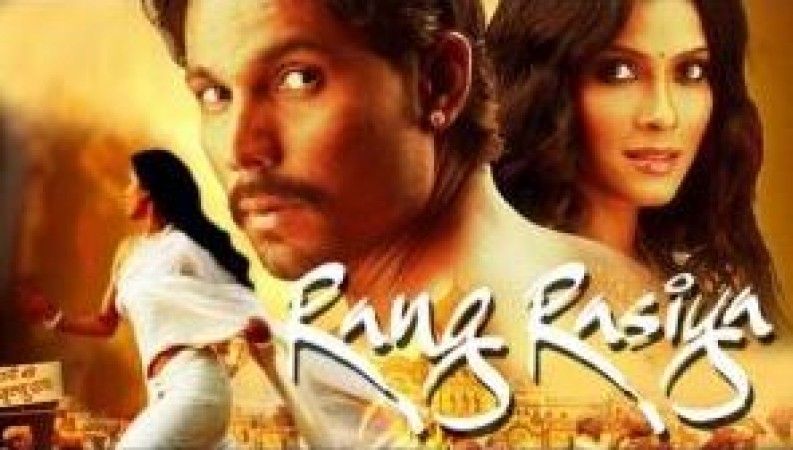
Within the film industry, narratives frequently go untold, films are not produced, and filmmakers' dreams are not always fulfilled. The story of the lost masterpiece "Rang Rasiya," which was first imagined as "Suryamukhi" in 2006, is one example of this. This movie was supposed to honour the life and creations of the famous Indian painter Raja Ravi Varma, but a string of unfavourable circumstances prevented it from ever being released. "Rang Rasiya," which starred Madhuri Dixit and Ajay Devgan and was directed by Shaji Karun, was hailed as a cinematic masterpiece that would have transported audiences to the fascinating realms of human emotion, history, and art.
Prior to exploring the narrative of "Rang Rasiya," it is imperative to comprehend the noteworthy historical and artistic context in which the film was shot. Raja Ravi Varma was a revolutionary painter who revolutionised Indian art. He was born in the princely state of Kilimanoor in 1848. Because of his role in bringing together European academic art techniques and Indian traditions, he is frequently referred to as the Father of Modern Indian Art. Raja Ravi Varma received praise and criticism for his realistic, Western portrayals of mythological figures and Indian deities.
Shaji Karun, the director, set out to explore Raja Ravi Varma's life and artistic legacy through film in 2006. At first, the movie was going to be a biographical drama called "Suryamukhi," which would explain the complex relationship that exists between art and the artist. Fans could expect a visual and emotional treat from the film, which starred the formidable acting duo of Ajay Devgan and Madhuri Dixit in the lead roles.
When Ajay Devgan was chosen to play Raja Ravi Varma, he perfectly embodied the visionary artist who defied conventional wisdom in Indian art. It was anticipated that his performance would bring Ravi Varma to life, highlighting both his passion for art and the challenges he encountered in his attempt to redefine Indian art.
Alternatively, Madhuri Dixit was supposed to portray Raja Ravi Varma's model and muse, Sugandha. Sugandha was not only the subject of paintings by Ravi Varma, but also a symbol of the shifting social mores and morals in 19th-century India, so her role in the movie was crucial.
"Suryamukhi" encountered several obstacles during filming, which ultimately resulted in the movie being shelved. The biggest obstacle was the decision to include some scenes of nudity that were thought to be necessary for maintaining the film's artistic integrity. Although these scenes were subtly included to show the creative process and the release of Raja Ravi Varma's artistic vision, questions were raised regarding Madhuri Dixit's comfort level and consent.
The well-known and respected actress Madhuri Dixit expressed doubts about these scenes, thinking they might not fit with her persona and the cultural sensitivities of the Indian audience. There was tension between her and the film's creative team because she was reluctant to be in these scenes. Still, the filmmakers stuck to their guns, saying that these sequences were essential to showing Raja Ravi Varma's creative transformation.
The film was ultimately cancelled due to a conflict between personal boundaries and artistic intent. With no other option, the producers decided to shelve "Suryamukhi," thereby bringing to light a tragic point in the history of filmmaking in which the ambitious plan for a biographical masterpiece was not realised.
For Indian cinema, "Suryamukhi" was a great loss to be abandoned. It had all the makings of a cinematic masterpiece, with Shaji Karun directing and Ajay Devgan and Madhuri Dixit playing the lead roles. The goal of the movie was to portray the spirit of Raja Ravi Varma's creative revolution, his bond with his muse Sugandha, and the social unrest that marked 19th-century India. It was very unfortunate that we were unable to use the talents of these outstanding people to examine these themes.
The story of "Suryamukhi" was eventually published, albeit in a different format, despite its regrettable demise. In the end, the movie was retitled "Rang Rasiya" and released in 2014. The film, which was directed by Ketan Mehta and starred Randeep Hooda as Raja Ravi Varma and Nandana Sen as his muse, vividly depicted the painter's creative process.
Even though it may not have been the grand cinematic production that "Suryamukhi" promised to be, "Rang Rasiya" succeeded in encapsulating both the artistic brilliance of Raja Ravi Varma and the social issues he had to deal with. The movie, though with new actors and a different perspective, examined the meeting point of art and culture in the 19th century.
The lost movie "Suryamukhi," which tells the story of the renowned painter Raja Ravi Varma, is still a moving part of Indian cinema history. The unfortunate shelving of it in 2006 resulted from a conflict between personal boundaries and artistic vision. Nonetheless, Raja Ravi Varma's legacy lives on thanks to his classic paintings and the ensuing motion picture adaptations. The film "Rang Rasiya," in spite of its difficulties, managed to tell the story of this legendary artist and inspire us with the strength of art and the unwavering determination of those who dare to redefine it.
How Paresh Rawal's 'Bheja' Tongue Twister Became a Cinematic Gem
The Minister and the Actress: Smriti Irani's Journey in 'All Is Well' (2015)